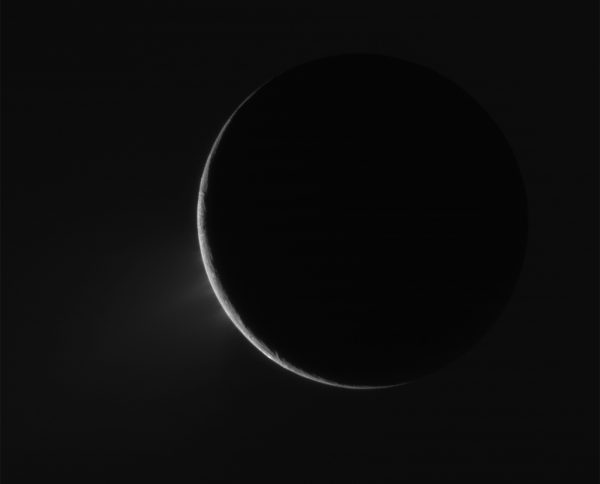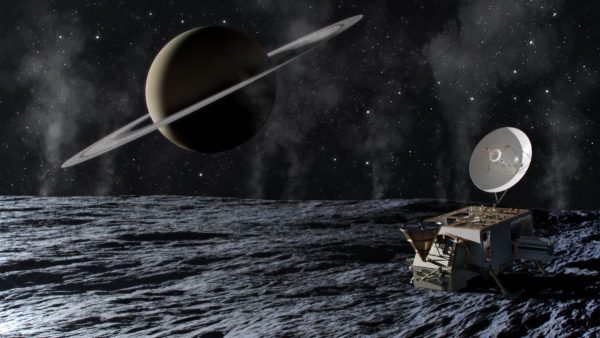A couple years ago, I wrote an article about how scientists were using the scientific method (yes, the one you learned about in school) in order to study the Enceladus ice plumes, which were discovered when Cassini was doing its fly-bys of several of Saturn’s moons. Well, they are still at it, and learning even more about this fascinating place in our solar system.
In brief: In 2005, astronomers and planetary scientists discovered icy plumes spraying out into space from Enceladus’s southern region. After a lot of modeling and hypothesis, they thought the most reasonable explanation for this was that Enceladus had a planet-wide ocean under a really thick (miles thick!) layer of ice. Scientists thought the moon generated enough heat to cause these plumes by a combination of tidal forces, radioactive decay, and friction from quakes near the moon’s core. New simulations, however, show that this scenario of the Enceladus ice plumes might not be entirely accurate.

At the fall meeting of the American Geophysical Union, a group of scientists from disciplines including planetary science and physics presented their findings that the Enceladus ice plumes could be coming not from the moon’s ocean, but from pockets of melted water closer to the surface. If this is true, it could throw a wrench into plans to study the ejecta from these plumes to get an idea about possible life in the ocean beneath the ice without having to drill all the way down to the ocean itself.
Scientists thought that if the plumes came through fissures in the thick ice that reached the ocean, the water would be a representative sample of the ocean water. Jacob Bufo, a planetary scientist from Dartmouth College, however, thinks we should use caution before making too many assumptions.
“Maybe we didn’t get the straw all the way through the ice shell to the ocean,” he says. “Maybe we’re just getting this weird pocket.” If the plumes are coming from a pocket of melted ice rather than from the ocean itself, “you could be sampling this slushy region in the middle of the shell, and that might not be the same chemistry as down in the ocean.”
Colin Meyer, a physicist from Dartmouth, explained that the plumes contained salts, which couldn’t be explained if they came from the ocean. The quake model of the plumes suggested that any salts that remained in the water as it rose from the ocean below up through the crack in Enceladus’s ice would be left on the surface of the moon as the water itself escaped into space in the form of a plume, much like how you have a layer of salts left on your skin after sweat evaporates on a hot day. The presence of salts in the plumes themselves suggest the salts were highly concentrated, which would be possible in pockets of meltwater within the icy shell of Enceladus itself.
The team used models based on Earth’s sea ice and applied them to the icy conditions on Enceladus. This modeling showed that it’s very possible for pockets of meltwater, or “mush,” to form within Enceladus’s ice-crust, and this material could be vented or ejected out into space in the form of icy, salty plumes.
What does this mean for the exploration of Enceladus? Life on Earth began in its oceans, and so it’s been postulated that the same could be true elsewhere. This makes Enceladus a prime candidate in our search for life beyond Earth. While collecting samples of the plumes would have been enticingly easy, we need to be careful to look at the situation from all angles. Say there are no organic molecules or signs of life in the Enceladus ice plumes. This doesn’t mean there is no life on the moon, it just means we haven’t explored all the possibilities yet. Research like Meyer and Bufo’s is really important because it keeps us aware of possibilities. Remember, all of this work is based on modeling, and we have no way of really knowing what’s going on under the icy shell of this moon of Saturn’s. Collecting samples from the plumes will be valuable no matter what. The information gathered might introduce new questions to be answered. Or it might give us some answers to existing ones.

Though some missions have been proposed, including the Enceladus Orbilander, there are no concrete plans for a mission to Enceladus yet. The south pole of the moon will be in sunlight in around the year 2050, and so that might be the prime year to target a mission, since with the sun’s heat, more ice plumes are likely. But first, NASA and the U.S. government need to be convinced that it’s worth the money. Funding is very hard to come by for non-military uses in the United States. If knowledge and learning are more important to you than a bloated military, this is a great time to write to your congresspeople and let them know you advocate for space exploration! Who knows, maybe we’ll find life in the solar system sooner rather than later, and the Enceladus ice plumes might be key in that search.




